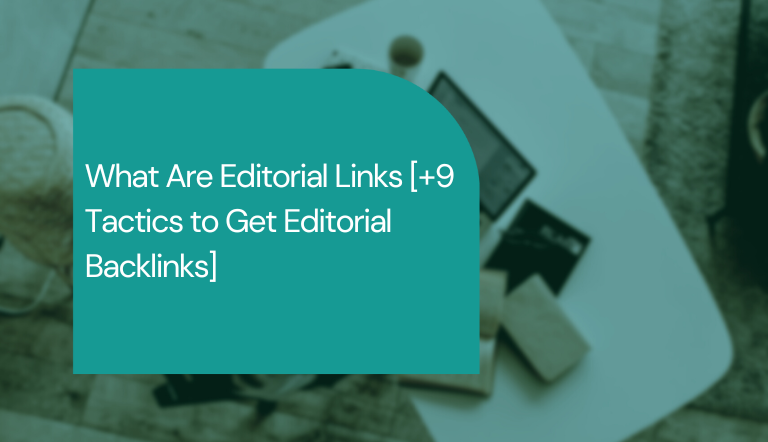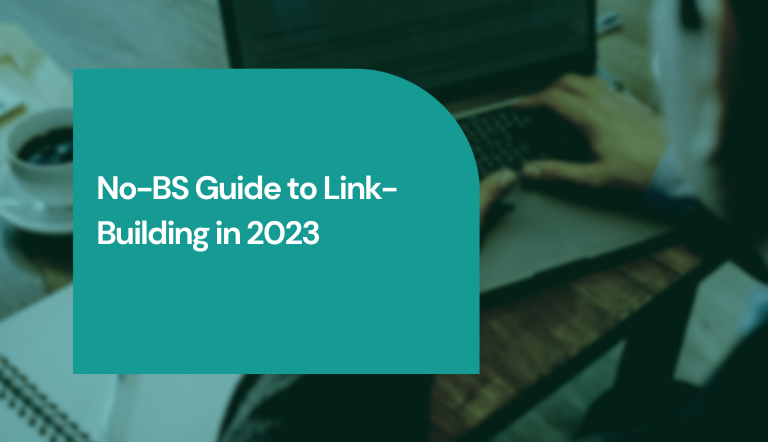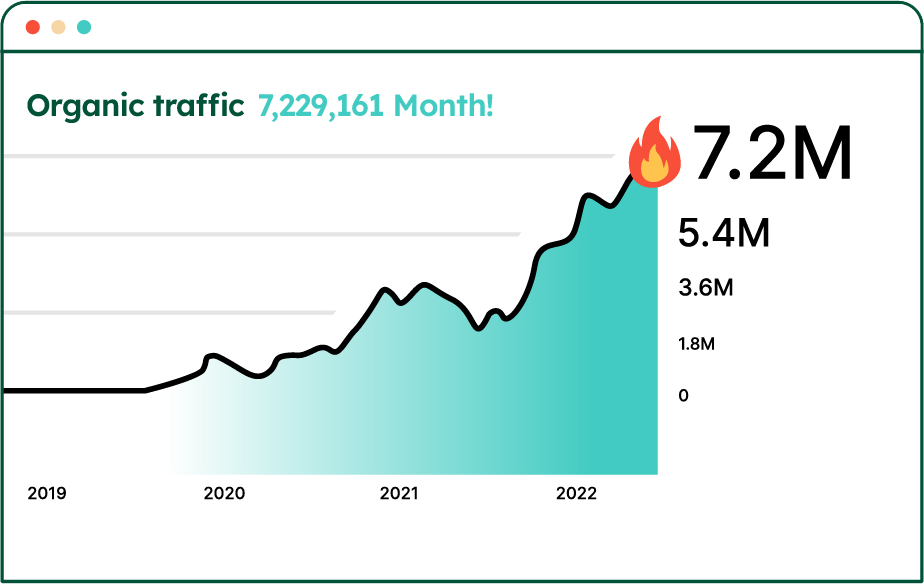Building editorial links is a great way to create backlinks for your website and start ranking higher on Google.
And the best part? They’re the type of links that require zero manual link-building outreach.
Intrigued? Great!
Read on to learn more about what editorial links are, their benefits, and 9 of our best tactics for building editorial links!
Let’s dive right in.
What Are Editorial Links?
Editorial links are the type of backlinks that are organically created by other blogs or publications. This means editorial backlinks are not bought, traded for, or even asked for.
An editor or a content writer stumbles upon your content, likes it, and decides to link to it from their website or blog post with no strings attached.
In contrast, acquired links (also known as manual links) are the polar opposite of editorial links. They’re the type of links you purchase, barter for, do an ABC swap for, etc.
For already established brands, editorial links are easy to acquire. Your content already ranks and gets a ton of readers, so it’s only natural for certain publications to organically link to your content.
If you’re a fresh business, though, things aren’t that cut and dry. If you want to build editorial links, you need to actively promote your content on social media such as Reddit, Facebook, Twitter, and more.
Examples of Editorial Links
There are different types of editorial links you can get for your website.
The first, for example, is the expert roundup editorial link. The writer of the article found the biggest SEO pros on the web and listed the ones with the biggest social media following in their article.
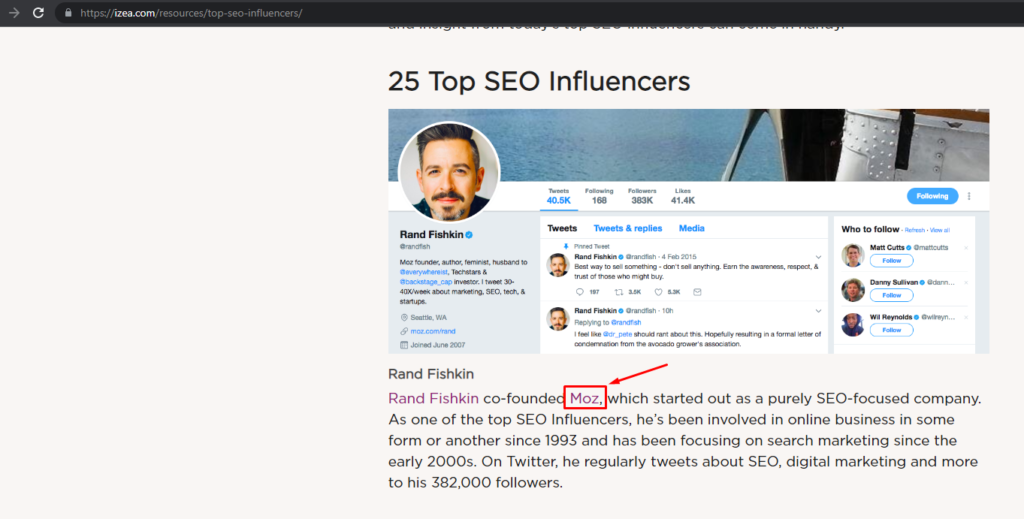
The following, on the other hand, is a source citation editorial backlink.
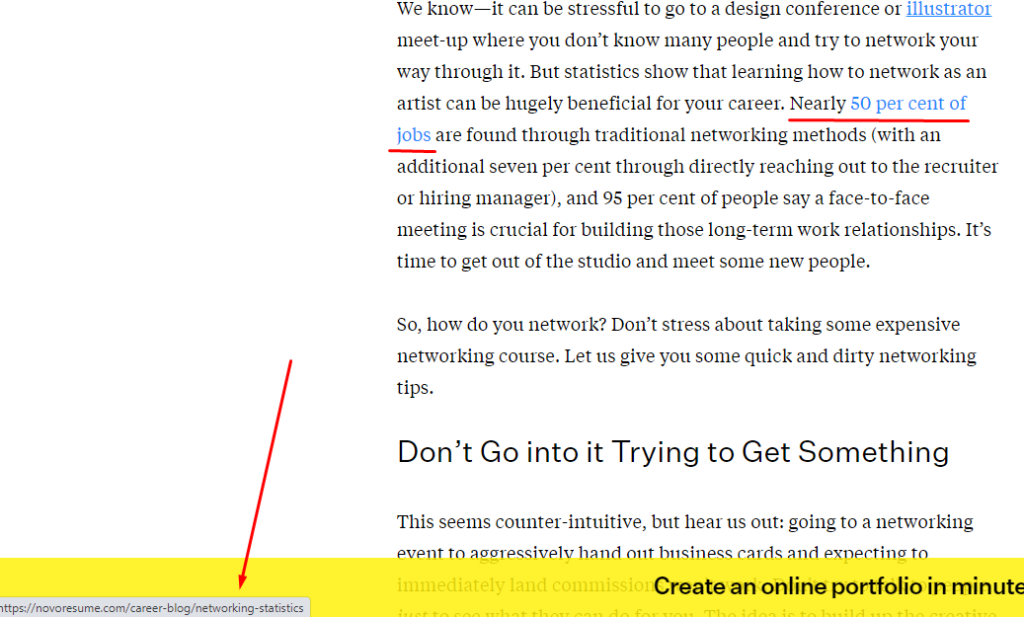
Basically, we created an article on networking statistics for one of our clients as a strategy to build editorial links.
Once our article started ranking, websites started linking to our article as a source for some statistic or another they took from there.
Finally, there’s the conventional editorial link – this is when someone simply links to your regular article just because they found it to be extremely useful.
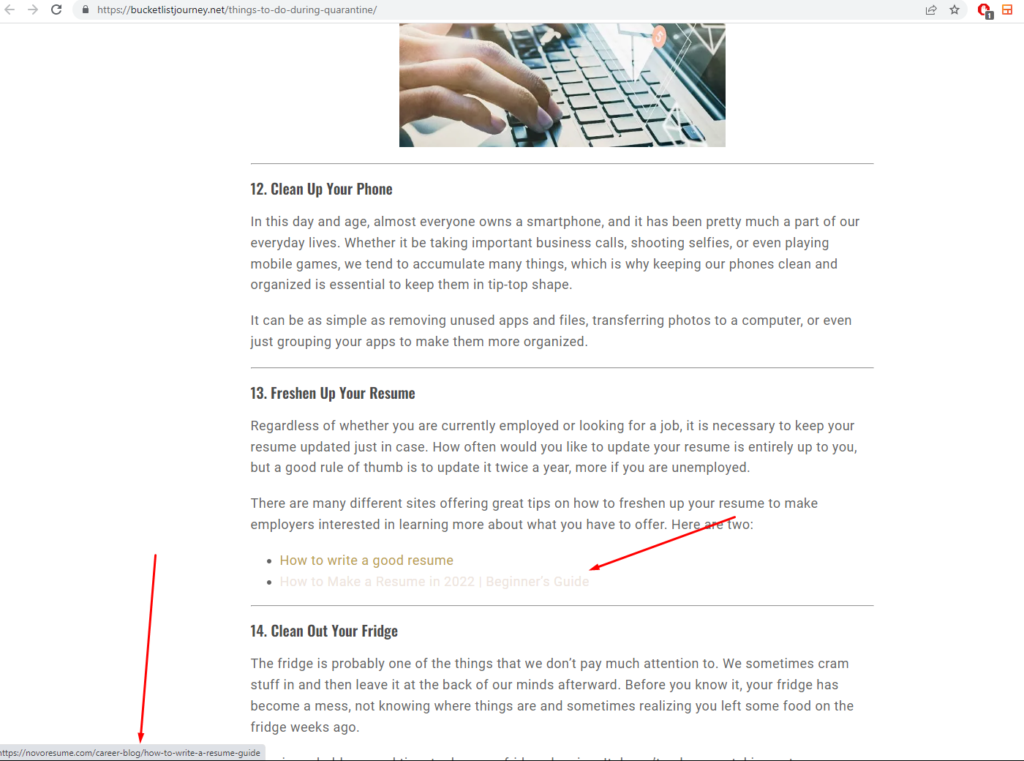
7 Editorial Link Benefits
- Better SEO rankings. The more obvious benefit of editorial links is that they’re backlinks, and as such, they help your website rank higher on Google.
- Referral traffic to your website. Editorial links usually also come with some traffic to your website. The readers of the blog/publication end up clicking on the link and discovering your website/product/service.
- Relationship building with website owners. If you notice that you’re getting editorial backlinks from specific websites, you can always reach out, thank them for the backlink, and potentially collaborate with them sometime down the road.
- Stronger brand. The more your website is mentioned organically, the stronger your brand becomes. Driving editorial links to your site means that people are finding your content and they’re loving your brand! The more editorial links you get, the more people can find your website, which in turn strengthens your brand.
- Becoming an authority in your niche. The more editorial links you get, the more authority you become in your field.
- Gaining a significant competitive advantage in terms of link-building. Regular editorial links can put you miles ahead of your competitors. You end up building links for free, whereas your competitors have to spend thousands of dollars on outreach every month.
- Homepage backlinks. Roundup editorial links usually result in backlinks for your homepage, which has a significant (positive) impact on your website’s overall traffic and rankings.
Struggling to get editorial backlinks? Check out our guide to ranking without links!
What are the Downsides of Editorial Links?
No link-building tactic is without its drawbacks.
When it comes to editorial links, there are two primary downsides.
One is that unless you’re already an established brand, editorial backlinks are going to be hard to build. You’ll need to spend a significant amount of time promoting your content and getting it seen on social media.
The other is that, unlike acquired links, you can’t control the quality and quantity of the editorial links you get. Some backlinks you get will be high quality, others not so much. One month you get 20 editorial links, and the other you may get zero.
As such, we always recommend doing editorial link-building in tandem with manual link-building.
How to Build Editorial Backlinks – 9 Best Tactics for 2022
Building editorial backlinks does not mean just sitting back and waiting for someone to link to your content.
There’s actually a lot you can do to make it a lot more likely for other websites to link to your content.
Check out our 9 best editorial link-building techniques below:
1. Create Epic Content
These days, the internet is PACKED with content.
Every single day, more than 4.4 million blog posts are published across all different platforms.
Most of the content on the internet, though, is of very low quality. Copy-paste content, short-form articles, content with no actionable insight or expert opinion, and so on.
Well, this exact type of content stands zero chance of driving editorial links.
Want to stand out from the crowd? You’ll want to focus on creating long-form, comprehensive content that is SO useful that bloggers can’t help but link to it.
Here are our top tips on how to do just that:
- Make your content as comprehensive as possible. If you’re creating another 500-word, surface-level article, no one’s going to care for it, or link to it. Aim for making your content long-form and detailed instead.
- Add expert insight where possible. Most articles on the web are created by professional content writers with no real experience with the topic they’re covering. If you want to stand out, you can add your personal expert insight on the topic.
- Feature experts in your posts. Don’t have the time to contribute to your own blog content? You can get outside experts to provide their insights instead. Find influencers in your niche and reach out asking for a quote for your article. Chances are, they’ll return the favor at some point and link to your site!
- Add screenshots and custom graphics. This helps make your content more reader-friendly. Some examples of blogs that do images right are Backlinko and HubSpot.
Struggling with creating quality content? You can try outsourcing your content creation!
2. Steal Your Competitor’s Link Magnets
Got a competitor that’s driving a ton of editorial backlinks to their website?
Here’s what you can do:
Run their website through Ahrefs or SEMrush and go to the “Best by Links” view:
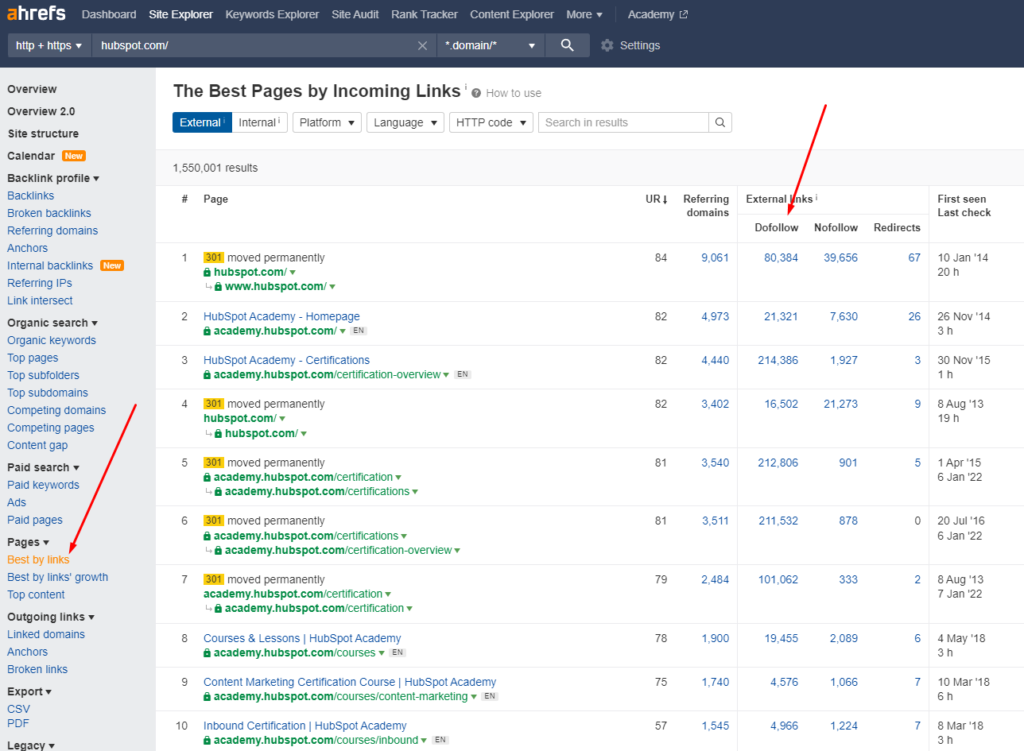
You’ll get a list of their pages sorted by the # of backlinks they have (in descending order).
You can use this tactic to generate content ideas that are more likely to drive editorial links to your website.
3. Target Statistics or Trends Keywords
Imagine this:
You’re a content writer looking for external sources to link to in your brand-new article.
What keywords would you Google to find such sources (and link to them)?
Usually, it’s something like this:
- [Topic] trends
- [Topic] statistics
- [Topic] statistics 2022,
And so on.
You should be catching our drift by now!
If you want content writers to organically stumble on your content and create editorial links for you, you should cover trends or statistics topics.
The process here is pretty simple – use Ahrefs or SEMrush to find statistics/trends keywords associated with your niche and create comprehensive articles targeting these keywords.
Want to make sure your stats articles outrank your competitors? Aim to deliver a LOT more value.
If your competitors have, say, 20 statistics each, you can aim for collecting 41+. This way, anyone Googling the keyword is a LOT more likely to click your link over your competitors.
4. Pitch Roundup Publishers
Look up roundup posts related to your niche and reach out asking for a feature.
For example, if you’re running a CRM software company, you can look up keywords like:
- Best CRM tools
- Best sales tools
- Outreach software
And other variations. Make a list of journalists who created such roundup posts and reach out asking if they can feature your company, too.
You can also do the exact same thing for influencer roundup posts. Instead of product keywords, look up keywords like:
- Sales influencers
- Outreach influencers
- SaaS influencers
And so on.
5. Be Open to Interviews
Sometimes, you’ll have small media owners reaching out to you inviting you for a quick interview.
Your gut reaction might be to think that these interviews aren’t particularly relevant to your business and are not likely to drive sales.
So, why should you care?
Why, because they drive editorial links, of course!
Each interview you attend can get you 1 to 3 new backlinks to your website, and in the best cases, the interview might even get syndicated by other websites, leading to even more editorial links to your site.
6. Take Advantage of Podcasts
Podcasts are more popular than ever, with over 155 million Americans have listened to them in the past year.
Whatever your SEO niche might be, there’s a very good chance that podcasters are covering the same topics you are.
Getting featured on these podcasts is a great way to build editorial links to your website!
Most podcasts, after all, offer 1-2 do-follow links to people they feature on their show.
You can go about getting featured on podcasts in two different ways:
- Wait for podcasters to reach out to you, and simply accept their invitation to their show.
- Go on a podcast tour. Create a list of podcasts in your niche and reach out to them one by one, offering yourself as a guest.
In your outreach email, make sure to include something about your brand that would make you an interesting guest for their podcast.
If you’re reaching out to a blog about side hustles, for example, you can pitch the podcast that you can talk about how you managed to grow your side hustle from 0 to 5-figures.
7. Try HARO
HARO, or help a reporter out, is a marketplace that matches journalists and prospective sources.
- The journalists submit their prompt with information on the type of experts they’re looking for.
- Sources get a personalized feed of journalists’ queries that match their interests.
From there, the source sends a personalized pitch to the journalist, and if they get picked, the journalist will cover them in their story (and include an editorial link back to their site).
This is a bit more of an active way to build editorial links, but the payoff is going to be worth your while!
HARO is a numbers game. If you want to use it to drive a sizable number of editorial links, you’ll want to send pitches daily.
Make sure your pitches are personalized, too, as journalists get hundreds of responses. Your pitch should be insightful enough for you to stand out from the crowd.
8. Feature Other Companies in your Content
Just like you would want to get other companies to feature you in their content and give you editorial links, other companies want the same thing.
So, here’s what you can do:
Whenever you have the opportunity, quote experts in your field inside your content and give them a free editorial link.
Then, reach out to them and let them know about the free backlink from your side.
From that point on, the company is also going to be likely to link back to your website sometime in the future as a favor, or you can always ask for a favor up-front!
9. Create Linkable Assets
Last but not least, you can create linkable assets to help drive organic editorial links to your website.
A linkable asset is a type of resource that’s specifically created for the purpose of attracting backlinks. These resources are SO useful that bloggers who read the article are very likely to find them helpful and link to them organically.
Some types of linkable assets you can create are:
- Infographics
- State of the Industry Reports
- Online Calculators
- Micro SaaS Websites
- Rankings Articles
And more! Check out the article by Ahrefs to learn more about how these work.
Key Takeaways
And that’s a wrap on our guide to editorial links!
Before you start implementing all the techniques we covered in this article, let’s do a quick recap of the most important things we talked about in this article:
- Editorial links are the type of links that are created organically by third parties. Such links are not paid for or bartered for.
- There are 7 main benefits of editorial links, including better site-wide rankings, increased referral traffic, stronger brand, and others.
- There are a ton of techniques for creating editorial links, but some of the most prevalent ones are: creating epic content, stealing competitor ideas, targeting statistics keywords, and others.

